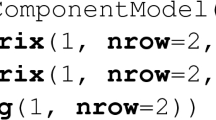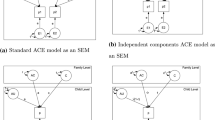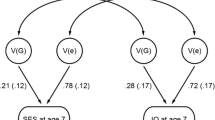Abstract
We propose the mixed model or multilevel model as a general alternative approach to existing behavior genetic analysis—an alternative to correlation analysis, the DeFries-Fulker analysis, and structural equation modeling. The mixed or multilevel model handles readily families of behavioral genetic data, which include paired sibling data (e.g., pairs of MZ and DZ twins) and clustered sibling data (e.g., a family of more than two biological siblings) as special cases. Not only can a family of behavioral genetic data have more than two siblings, it can also contain multiple types of siblings (e.g., a pair of MZ twins, a pair of DZ twins, a full sibling, and a half sibling). In contrast to the traditional approaches, the mixed or multilevel model is insensitive to the order of the siblings in a sibling cluster. We apply our approach to a large, nationally representative behavior genetic sample collected recently by the Add Health Study. We demonstrate the approach through several applications using both clustered and family complex behavioral genetic data: conventional variance decomposition analysis, analysis of interactions between genetic and environmental influences, and analysis of the possible genetic basis for friendship selection. We compare results from the mixed or multilevel model, Pearson's correlation analysis, and the structural equation model.
Similar content being viewed by others
REFERENCES
Bearman, Peter S., Jones, Jo, and Udry, J. Richard (1997). The National Longitudinal Study of Adolescent Health: Research Design [WWW document]. URL: http://www.cpc.unc.edu/ projects/addhealth/design.html
Berkowitz, William R. (1969). Perceived height, personality, and friendship choice. Psychological Reports 24:373–374.
Berscheid, Ellen, and Walster, Elaine (1978). Interpersonal Attraction, 2nd ed., Random House, New York.
Bouchard, Thomas J., Jr., Lykken, David T., McGue, Matthew, Segal, Nancy L., and Tellegen, Auke (1990). Sources of human psychological differences: The Minnesota Study of Twins Reared Apart. Science 250:223–228.
Bryk, Anthony S., and Raudenbush, Stephen W. (1992). Hierarchical Linear Models: Applications and Data Analysis Methods SAGE, Newbury Park, CA.
Cherny, S. S., DeFries, John C., and Fulker, David W. (1992). Multiple regression analysis of twin data: A model-fitting approach. Behavior Genetics 21:489–497.
Cook, L. S., Goldoft, M., Schwartz, S. M., and Weiss, N. S. (1999). Incidence of adenocarcinoma of the prostate in Asian immigrants to the United States and their descendants. Journal of Urology 161:152–155.
DeFries, John C., and Fulker, David W. (1985). Multiple regression analysis of twin data. Behavior Genetics 15:467–473.
Eaves, L. J., and Gale, J. S. (1974). A method for analyzing the genetic basis of covariation. Behavior Genetics 4:253–267.
Eaves, L. J., Last, K. A., Young, P. A., and Martin, N. G. (1978). Model fitting approaches to the analysis of human behavior. Heredity 41:249–320.
Goldstein, Harvey (1987). Multilevel Models in Educational and Social Research, Griffin, London.
Goldstein, Harvey (1995). Multilevel Statistical Models, 2nd ed., Arnold, London; Halstead, New York.
Gottesman, I. I. (1991). Schizophrenia Genesis: the Origins of Madness, W. H. Freeman, New York.
Grilo, C. M., and Pogue-Geile, Michael F. (1991). The nature of environmental influences on weight and obesity: A behavior genetic analysis. Psychological Bulletin 110:520–537.
Mason, William M., Wong, G. M., and Entwisle, Barbara (1983). Contextual analysis through the multilevel linear model. Sociological Methodology 15:72–103.
Neale, C. Michael, and Cardon, Lon R. (1992). Methodology for Genetic Studies of Twins and Families, Kluwer Academic Publishers, Boston/London.
Plomin, Robert, Owen, Michael J., and McGuffin, Peter (1994). The genetic basis of complex human behaviors. Science 264: 1733–1739.
Popkin B., and Udry, J. R. (1998). Adolescent obesity increases significantly in second and third generation U.S. immigrants: The National Study of Adolescent Health. Journal of Nutrition 128:701–706.
Rodgers, Joseph L., and McGue, Matt (1994). A simple algebraic demonstration of the validity of DeFries-Fulker analysis in unselected samples with multiple kinship levels. Behavior Genetics 24:259–262.
Rowe, David C. (1994). The Limits of Family Influences: Genes, Experience, and Behavior, The Guilford Press, New York.
Rowe, David C., Jacobson, Kristen C., and van den Oord, Edwin J. C. G. (forthcoming). Genetic and environmental influences on vocabulary IQ: Parental education level as moderator. Child Development.
Searle, S. R. (1971). Linear Models, Wiley, New York.
Searle, S. R., Casella, George, and McCulloch, Charles E. (1992). Variance Components,Wiley, New York.
Tsuang, Ming T., and Faraone, Stephen V. (1990). The Genetics of Mood Disorders, Johns Hopkins University Press, Baltimore.
Udry, J. Richard (1996). Biosocial models of low fertility societies. Population and Development Review 22 (Suppl.): 325–336.
Author information
Authors and Affiliations
Rights and permissions
About this article
Cite this article
Guo, G., Wang, J. The Mixed or Multilevel Model for Behavior Genetic Analysis. Behav Genet 32, 37–49 (2002). https://doi.org/10.1023/A:1014455812027
Issue Date:
DOI: https://doi.org/10.1023/A:1014455812027




